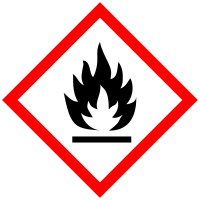
Improving Member States preparedness to face an HNS pollution of the Marine System (HNS-MS)
Acetone
Description Top
| CAS number | 67-64-1 |
| UN number | 1090 |
| Chemical formula | C3H6O |
| Accident occurred | Yes |
| Standard European Behaviour Classification (SEBC) | Dissolver that evaporates (DE) |
| Abilities | Miscible in water. |
GESAMP Hazard profile
| A1 | A2 | B1 | B2 | C1 | C2 | C3 | D1 | D2 | D3 | E1 | E2 | E3 |
| 0 | R | 0 | 0 | 0 | 0 | 0 | 1 | 2 | NT | DE | 2 |
Marine pollution Classification (MARPOL Annex II)
| Category | Description |
| Z | Noxious Liquid Substances which, if discharged into the sea from tank cleaning or deballasting operations, are deemed to present a minor hazard to either marine resources or human health and therefore justify less stringent restrictions on the quality and quantity of the discharge into the marine environment. |
Alternate names for this chemical
Dimethyl Formaldehyde
Dimethylketal
Dimethyl Ketone
Ketone Propane
Beta-Ketopropane
Methyl Ketone
2-Propanone
Pyroacetic Acid
Pyroacetic Ether
Propanone
Acetone
Dimethylketal
Dimethyl Ketone
Ketone Propane
Beta-Ketopropane
Methyl Ketone
2-Propanone
Pyroacetic Acid
Pyroacetic Ether
Propanone
Acetone
Physico-chemical properties Top
| Chemical formula | C3H6O | |||||
| Molar mass | 58.08 [g/mol] | |||||
| Critical molar volume | 0.000213 [m³/mol] | |||||
| State | Liquid at 25°C and 1 atm | |||||
| Fusion temperature | -95.35 [°C] | |||||
| Boiling temperature | 56.2 [°C] | |||||
| Critical temperature | 508.1 [°C] | |||||
| Density |
|
|||||
| Surface tension |
|
|||||
| Kinematic viscosity |
|
|||||
| Hydrosolubility |
|
|||||
| Vapour pressure |
|
|||||
| Critical pressure | 4700000 [Pa] | |||||
| Vapour density | 2.2 | |||||
| Flash point (Pensky-Martens closed cup) | -20 [°C] | |||||
| Flash point (Cleveland open cup) | -15.6 [°C] | |||||
| Lower explosivity limit (LEL) | 2.6 [%] | |||||
| Upper explosivity limit (UEL) | 12.8 [%] | |||||
| Vaporization enthalpy |
|
|||||
| Combustion enthalpy | 28600000 [J/Kg] | |||||
| Specific heat capacity | 2174.59 [J/(Kg·K)] | |||||
| Combustion efficiency | 96 [%] | |||||
| Mass flow rate of the combustion surface | 0.05 [Kg/(m²·s)] | |||||
| Radiative fraction | 27 [%] | |||||
| Henry's constant | 4.31 [mol/(m³·Pa)] |
Behaviour Top
| Log Kow | -0.24 |
| Log Koc | 0.73 |
| Hydrolysis (Half-life) | Not hydrolysable |
| Aqueous photolysis (Half-life) | 1.67 days |
| Biodegradation in estuary environment (Half-life) | 10 days |
| Biodegradation in marine environment (Half-life) | 10 days |
| Standard European Behaviour Classification (SEBC) | Dissolver that evaporates (DE) |
| Bioconcentration factor (BCF) | 0.69 |
Ecotoxicity Top
| Lowest median lethal concentration (LC50) on algae | > 10000 [mg/l] | ||
| Lowest median lethal concentration (LC50) on crustacean | 2100 [mg/l] | ||
| Lowest median lethal concentration (LC50) on fishes | 6070 [mg/l] | ||
| Highest no observed effect concentration (NOEC) on algae | 3400 [mg/l] | ||
| Highest no observed effect concentration (NOEC) on crustacean | 1660 [mg/l] | ||
| Assessment factor (AF) |
|
||
| Predicted No Effect Concentration (PNEC) |
|
Hazards Top


Danger
| IDLH | 2500 [ppm] |
Hazards statements
Physical
H225
Highly flammable liquid and vapour.
Health
H319
Causes serious eye irritation.
H336
May cause drowsiness or dizziness.
GESAMP Top
GESAMP Hazard profile
| A1 | A2 | B1 | B2 | C1 | C2 | C3 | D1 | D2 | D3 | E1 | E2 | E3 |
| 0 | R | 0 | 0 | 0 | 0 | 0 | 1 | 2 | NT | DE | 2 |
A1: Bioaccumulation
| Rating | Description |
| 0 | No potential to bioaccumulate |
A1a:
| Rating | Description | Criteria [mg/l] |
| 0 | No potential to bioaccumulate | Log Kow < 1 |
A1b:
| Rating | Description | Criteria |
| 0 | No potential to bioaccumulate | No measurable bioconcentration factor (BCF) |
A2: Biodegradation
| Rating | Description |
| R | Readily biodegradable |
B1: Acute aquatic toxicity
| Rating | Description | Criteria [mg/l] |
| 0 | Non-toxic | LC/EC/IC50 > 1000 |
B2: Chronic aquatic toxicity
| Rating | Description | Criteria [mg/l] |
| 0 | Negligible | NOEC > 1 |
C1: Acute oral toxicity
| Rating | Description | Criteria [mg/Kg] |
| 0 | Negligible | AOTE > 2000 |
C2: Acute dermal toxicity (skin contact)
| Rating | Description | Criteria [mg/Kg] |
| 0 | Negligible | ADTE > 2000 |
C3: Acute inhalation toxicity
| Rating | Description | Criteria [mg/l] (4 hours exposure) |
| 0 | Negligible | AITE > 20 |
D1: Skin irritation or corrosion
| Rating | Description | Sign | GHS category |
| 1 | Mildly irritating | Mild erythema with or | Mild Irritant Category 3 |
D2: Eye irritation
| Rating | Description | Sign | GHS category |
| 2 | Irritating | Marked conjunctival hy | Irritant Category 2A |
D3: Long-term health effects
| Notation | Hazard endpoint | Description | GHS category |
| No Information |
E1: Tainting of seafood
| Rating | Description |
| NT | The substance has been tested for tainting and found not to taint following exposure of the fish for 24h to 1mg/l. |
E2: Behaviour of chemicals in the marine environment
| Rating | Description |
| DE | Dissolver that evaporates |
E3: Interference with the use of coastal amenities
| Rating | Interference | Description | Interpretation | Warning |
| 2 | Moderately objectionable | 1 is a persistent floater; and/or 2 is moderately acutely toxic; and/or 3 is irritating to skin and/or eyes; and/or 4 has long-term health effects other than carcinogenicity, mutagenicity or reprotoxicity; and/or 5 is highly flammable; and/or 6 is moderately flammable and is a floater with evaporative properties | 1 E2 = Fp; and/or 2 C1 and/or C2 and/or C3 = 23; and/or 3 D1 and/or D2 = 2; and/or 4 D3 contains Ss, Sr, T, A, N, or I; and/or 5 Flashpoint <23°C; and/or 6 Flashpoint 23°C to 60°C and E2 = FE or FED | Warning issued and possible closure of amenities |
GHS Security Information


Danger
About the project
HNS-MS is a decision-support tool that Belgian and French maritime authorities as well as coastguard stations can activate in order to forecast the drift, fate and behavior of acute marine pollution by Harmful Noxious Substances (HNS) accidentally released in the marine system.
Contact us
Copyright © 2015–2026 HNS-MS Consortium
 HNS-MS has been funded by DG-ECHO under agreement ECHO/SUB/2014/693705 and runs from 1 January 2015 to 31 March 2017.
HNS-MS has been funded by DG-ECHO under agreement ECHO/SUB/2014/693705 and runs from 1 January 2015 to 31 March 2017.